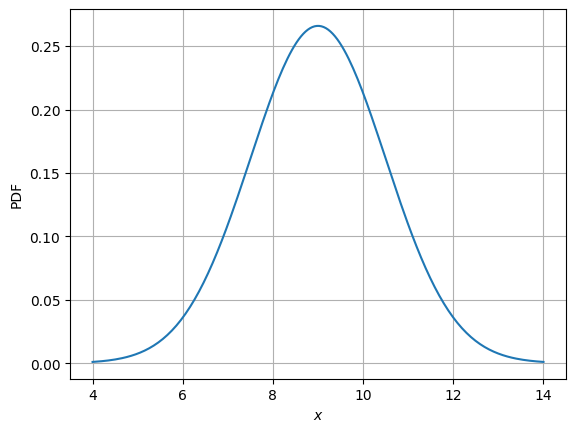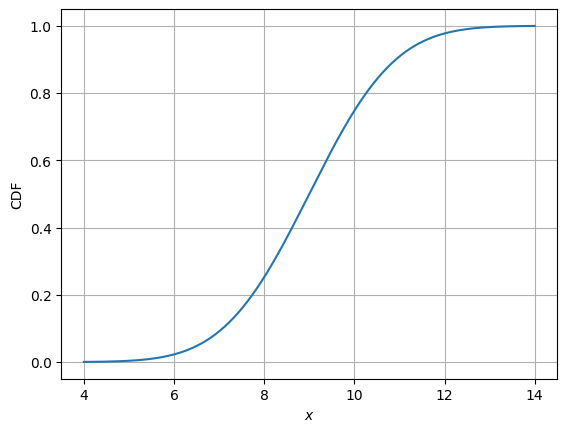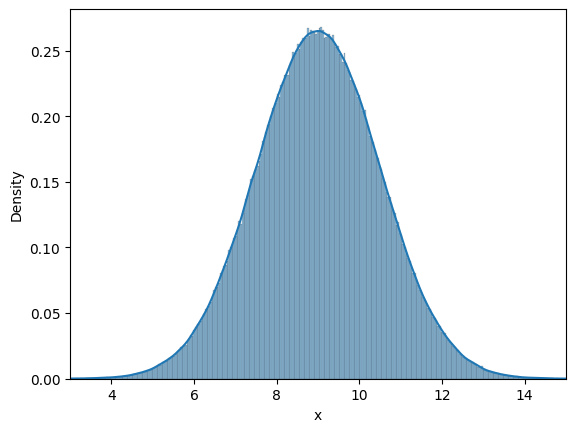Normal Distribution#
A continuous random variable \(X\) is said to have a normal distribution (or Gaussian distribution) with parameters \(\mu\) and \(\sigma\), where \(-\infty \leq \mu \leq \infty\) and \(\sigma > 0\), if the pdf of \(X\) is
The statement that \(X\) is normally distributed with parameters \(\mu\) and \(\sigma\) is often abbreviated as \(X \sim \mathcal{N}(\mu,\sigma)\). We will perform an exercise as we did with uniform distribution.
Example: Suppose the force acting on a column that helps to support a building is a normally distributed random variable \(X\) with mean value 9 N and standard deviation 1.5 N.
Now, let’s use norm object within scipy.stats module to answer various questions related to this example. Reading the documentation for normal distribution implemented in scipy will help.
Following block imports all the required packages:
from scipy.stats import norm # Imports normal distribution
import matplotlib.pyplot as plt
import numpy as np
import seaborn as sns
Question: Compute mean, variance, and standard deviation.
Answer: This is very straight-forward since it is gaussian distribution, but just to demostrate, we will use norm object.
loc = 9 # mean
scale = 1.5 # std dev
# Creating normal distribution object with fixed mean and variance
rv = norm(loc=loc, scale=scale)
# Compute mean of the distribution
print("Mean for this distribution: {}".format(rv.mean()))
# Compute variance of the distribution
print("Variance for this distribution: {}".format(rv.var()))
# Compute std-dev of the distribution
print("Standard deviation for this distribution: {}".format(rv.std()))
Mean for this distribution: 9.0
Variance for this distribution: 2.25
Standard deviation for this distribution: 1.5
Question: Compute \(P(X \leq 8.8)\)
Answer: \(P(X \leq 8.8) = F(8.8)\). So, we need to compute cdf of normal distribution at 8.8. Following block of code shows how to do that:
# P(X <= 8.8)
rv.cdf(8.8)
0.4469648833763862
Question: Compute \(P(X \leq 11)\)
Answer: \(P(X \leq 11) = F(11)\). So, we need to compute cdf of normal distribution at 11. Following block of code shows how to do that:
# P(X <= 11)
rv.cdf(11)
0.9087887802741321
Question: Compute \(P(X \geq 7.5)\)
Answer: \(P(X \geq 7.5) = P(X > 7.5) = 1 - P(X \leq 7.5) = 1 - F(7.5)\). So, we need to compute cdf of normal distribution at 7.5. Following block of code shows how to do that:
# P(X >= 7.5)
1 - rv.cdf(7.5)
0.8413447460685429
Question: Compute \(P(9 \leq X \leq 10)\)
Answer: \(P(9 \leq X \leq 10) = F(10) - F(9)\). So, we need to compute cdf of normal distribution at 9 and 10. Following block of code shows how to do that:
# P(9 <= X <= 10)
rv.cdf(10) - rv.cdf(9)
0.2475074624530771
Question: Plot the pdf and cdf for this example.
Answer: We can use the rv variable created in previous block and compute value of pdf and cdf at a bunch of x values. Then, use matplotlib to plot them. Code in the following block executes this task.
# Creating array of x values at which pdf and cdf will be computed while plotting
x = np.linspace(4, 14, 200)
# Plotting PDF
fig, ax = plt.subplots()
ax.plot(x, rv.pdf(x))
ax.set_xlabel("$x$")
ax.set_ylabel("PDF")
ax.grid()
plt.show()
# Plotting CDF
fig, ax = plt.subplots()
ax.plot(x, rv.cdf(x))
ax.set_xlabel("$x$")
ax.set_ylabel("CDF")
ax.grid()
plt.show()


Similar to last case, we will look into frequency interpretation of probability. Below code plots the distribution of randomly drawn samples as you increase the number of samples. Since the number of samples will be high, it might take some time to generate the plots.
# Some parameters
initial_samples = 10
iter = 6
for i in range(iter):
# Number of samples
samples = initial_samples*10**(i)
# Generate samples from the distribution
data = rv.rvs(size=samples)
# Plotting using seaborn
fig, ax = plt.subplots()
plot = sns.histplot(data, stat="density", ax=ax, kde=True)
ax.set_xlabel("x")
ax.set_xlim([3, 15])






Similar to previous case, as the number of samples increase, the density curve approaches theortical normal density curve. You can play around with the value of iter, initial_samples, and see how distribution changes.